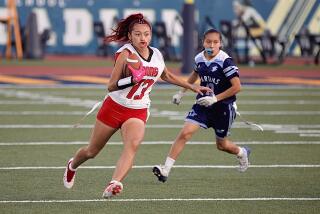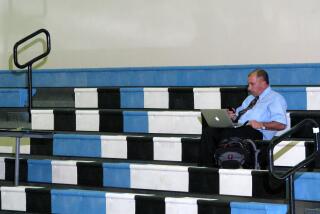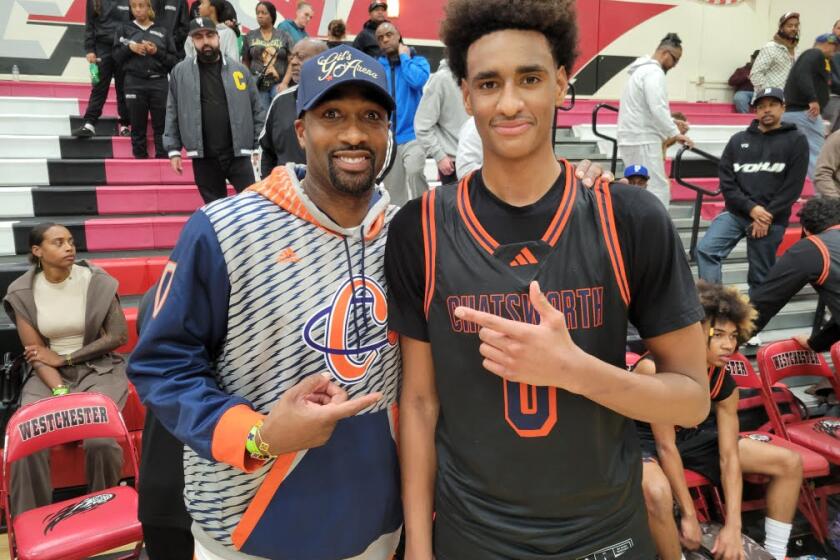A-11 offense causing a stir
Offensive linemen love it, game officials tend to hate it and some high school athletic associations are plotting to stop it.
The A-11 offense has created such a stir since its creation last year that it might as well be known as the A-!! offense. It is a formation in which any of a team’s 11 players could become eligible to catch a pass, leading to mass confusion among defensive players, their coaches, fans and, well, just about everyone.
Loosely translated, the A-11 is a cross between a spread formation and a schoolyard free-for-all in which the quarterback tells everyone to go out for a pass.
In its basic configuration, two quarterbacks line up at least seven yards deep in the backfield behind a three-man offensive line -- a center flanked by two tight ends -- with “pods” of three receivers split to each side.
Coaches are hereby advised not to try this at home or in North Carolina, where the first attempt to run the A-11 will result in a 15-yard unsporting penalty and the second in disqualification of the head coach.
Gary Chambers, the only coach in Southern California running the A-11 this season, doesn’t understand why anyone wouldn’t want to at least give it a shot.
“It’s something that really fits with small schools like us who have a fair amount of skill guys but not a lot of size, not a lot of brawn,” said Chambers, whose team represents Saddleback Valley Christian High, enrollment 240. “You’ve got a few guys who would be third-string wide receivers but now they’re first-string A-11 guys.”
The six players eligible to catch a pass are not determined until one count before the snap, when the required seven players establish their position at the line of scrimmage. The eligible players are the four lined up behind the scrimmage line and the two farthest outside on either side of the ball; offensive linemen become eligible by not wearing jersey Nos. 50-79.
The scheme makes for some unlikely heroes.
At Saddleback Valley Christian, senior center Clayton Viter became the talk of the team last month when he made a diving catch for a first down against Huntington Beach Brethren Christian.
“Imagine being a center and going out on a route and diving for a catch,” senior receiver Josh Squirrell said, a trace of disbelief in his voice. “What other school does that?”
Not many. Piedmont High in Northern California is believed to be the only other school in the state to run the A-11, and schools in at least five states are banned from using it by their respective athletic associations.
“Some do not think it complies with the rules and some have concerns about it being able to be officiated,” said Bob Colgate, assistant director of the National Federation of State High School Assns.
The NFSH ruled the A-11 legal because it uses the scrimmage-kick formation, which allows players to become eligible to receive a pass as long as they are wearing acceptable jersey numbers and at least one player is lined up seven yards deep in the backfield with no quarterback under center. Some teams increase their options by using two or more players deep in the backfield.
Chambers was surfing the Internet last summer when he stumbled upon the formation, devised in early 2007 by Piedmont coaches Kurt Bryan and Steve Humphries. Some SVC players were skeptical when they heard they would be abandoning the spread offense. Then they got a feel for the A-11.
“It’s fun because you can get everyone involved on the field,” senior receiver Michael Cannavo said. “You can run a lot of things out of it -- sweeps, passing plays, direct snaps.”
Not that SVC has magically morphed into a scoring juggernaut. The Warriors (5-0) were averaging only 21 points before they dropped 70 last week on winless Riverside California School for the Deaf.
Anaheim Fairmont Prep Coach Bobby Mendoza, whose team lost to SVC, 14-7, earlier this month, called the formation “a very exaggerated spread. . . . If you don’t do your homework and prepare for it, it gives you headaches. But it’s nothing mind-blowing in any way.”
Chambers was hoping to hold the A-11 in reserve for his team’s third game, against Brethren Christian, because he figured it would be the Warriors’ first major test. But with his team struggling to move the ball in its opener against Burbank Bell-Jeff, Chambers unveiled the formation in the second half.
Concerned about how officials might react, Chambers had asked SVC Athletic Director Rod Markum to call the Southern Section office the week before the game. Markum received assurances that the officials were versed in the nuances of the A-11.
Not so, it turned out.
“We came out in it and they just freaked,” Chambers said. “They couldn’t figure it out. I kept trying to explain it and [they would respond], ‘Oh, no, there’s no such thing. You guys are crazy. I don’t know where you make this stuff up.’ So we went back to our regular offense.”
The officials who called SVC’s game the following week also weren’t thrilled with Chambers -- for a different reason.
“They came up to me before the game and said, ‘You’re the guy who made us miss dinner last night,’ ” Chambers said. “ ‘We were in a meeting for three hours on your stupid offense.’ ”
By the Warriors’ fourth game, the buzz surrounding the A-11 was so intense in officiating circles that the crew assigned to the game was one typically reserved for games involving powerhouses such as Santa Ana Mater Dei and Long Beach Poly.
The phenomenon has also drawn attention in some unlikely media outlets, including National Public Radio and Scientific American magazine, which noted there are 16,632 permutations for who receives the snap and who ends up with the ball.
The A-11 may soon be on display in your living room. Bryan, the Piedmont coach, said some of the nation’s top senior players could experience the offense in a proposed televised A-11 all-star game early next year in Southern California.
Not everyone wants to see the offense go prime time. There is already a movement afoot to eliminate the offense in the Southern Section. One member of the section’s football advisory committee, speaking on condition of anonymity because he did not want to publicly divulge his position, said he hoped the committee would vote to eliminate the A-11 before next season because it was a deceitful formation that exploited a loophole in the rules.
Though he knew the potential for a backlash existed the moment he installed the offense, Chambers says he hopes the A-11 not only survives but thrives.
“You certainly can’t call it unsporting,” Chambers said. “I mean, you might call it juvenile. You might call it flag football. But you can’t call it unsportsmanlike because it certainly isn’t.
“I think by next year there will be a lot of teams like us realizing it’s a great offense.”
Given, of course, they get the chance to run it.
--
More to Read
Get our high school sports newsletter
Prep Rally is devoted to the SoCal high school sports experience, bringing you scores, stories and a behind-the-scenes look at what makes prep sports so popular.
You may occasionally receive promotional content from the Los Angeles Times.







